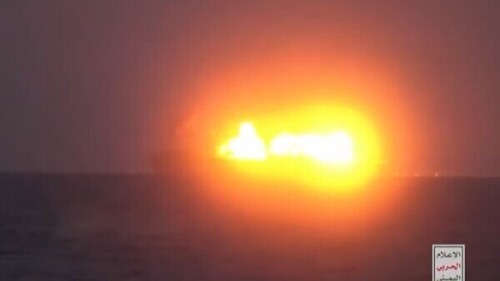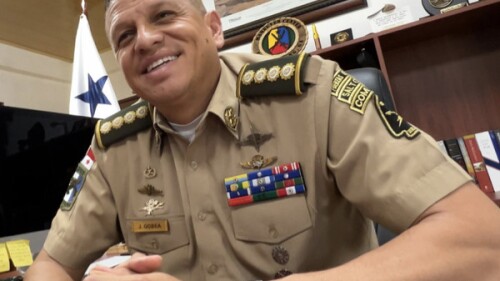Rafael uses Ghost Robotics’ SPIRIT four-legged robot to carry out surveillance and attack missions indoors. (Rafael) |
On the back porch of a rundown building near the sea in central Israel a plank leads to an unlikely machine. A robot dog is surveying the area, preparing for a mission. Alongside it, like a sidekick, a drone is hovering and awaiting orders. Soon the two systems will enter the building, mapping it room by room and identifying threats. In another room a wall of computer screens are mounted were soldiers will see the feed coming back from the robots. A three-dimensional model of the rooms that are mapped will be printed and a team will analyze the building to understand the threats within. A short video of the operation in progress can be seen below.
This demonstration was done in December by Rafael Advanced Defense Systems, one of Israel’s major defense companies and the traditional research and development wheelhouse behind the Israel Defense Forces technological advancements. Rafael built Israel’s Iron Dome air defense system and the Trophy system used to protect Israeli and American tanks. It is also at the forefront of targeting and using electro-optics for surveillance. The driving force now behind all this is the latest advancements in artificial intelligence and what the company calls “automatic target recognition.” In essence that means that a targeting pod on a plane, or a missile or a robot dog can see a truck or an RPG and determine if it is a threat or if the RPG is actually just a broomstick.
This matters in today’s battlefield because unlike the First World War or Vietnam-era where you could just bombard enemies into submission and destroy civilian infrastructure to do it, modern armies want as close to zero casualties as possible. That means zero casualties among your own force and no civilians killed. If enemies can be neutralized in a more precise manner, using maximum lethality, that is also better, than waging a war of attrition. This is what Israel is doing through its multi-year Momentum plan.
Rafael’s demonstration of its “indoor” capabilities (click on video to the left) is designed to showcase how robots and drones can work together using the open architecture technology that Rafael has developed. For them it’s not about the platforms, such as the robot dog which is named Spirit from Ghost Robotics, or the drones, named Raven, it’s more about the sensors you pack the machines with and how those sensors bring back data and fuse the data using other systems the company has such as Fire Weaver. Rafael has been developing a plethora of networked technology that it sees as transforming the digital battlefield. What that means is a commander and officers now have more access to computers and can see on screen where their forces are, identify the threats and decide which force can be used to neutralize the threat. This is important in an urban environment because you might have one enemy sniper or RPG-team and getting at that enemy through a window is important. But which force will you use?
Modern militaries often have too much in the way of technology and information. The challenge is not really about having enough weapons, it’s about finding the right weapon, whether using a missile from an F-35, or a loitering munition such as Rafael’s Firefly missile, or special forces with rifles. With developments of more artificial intelligence and automatic target recognition the burden on commanders to have to deal with too much incoming data is reduced while preserving the issue of having a “man in the loop.” In essence that means not letting the technology decide who to kill, because that would look a little too much like the nightmares envisioned in films like Terminator.
During the demonstration Rafael’s Shmuel Olanski, the vice-president and head of land innovation programs as well as Noam Barak, head of the innovation center and research and development of the engineering division of the company, spoke about the advances. The modern battlefield is developing rapidly, and the need to make ground forces more digital is clear. This has already been accomplished for naval and air forces and is being input into tanks. Ground forces need more technology at their fingertips and they need to be able integrate it so it doesn’t burden soldiers, but rather leverages their capabilities. A rifleman can’t be distracted with a hand-held tablet all the time. But giving the soldier better tools to know what is in the houses in front of them, where terrorists may be lurking among civilians, is essential. This is the “multi-dimensional” battlefield that Israel is seeking to revolutionize.
In the demonstration in December Rafael sent its robot dog and drones into a building to clear nine rooms and identify the threats there. The unmanned systems found nine people in the rooms, five rifles and an RPG. On a tour of the facility, mocked up with a photo of Hezbollah’s Hassan Nasrallah to make it feel authentic, we could see what the robots had seen previously.
The demonstration leads to questions about what comes next. Slow-moving robot dogs can be shot at by terrorists, unless they are all sleeping. Drones are also noisy. These kinds of issues are still technological hurdles. That is why Rafael is focusing more on the sensors and technology that can be plugged into the platform than on the platforms themselves. Robots are going to become increasingly more stealthy and flexible. There will be robot snakes and smaller, quiet drones. Israel is at the forefront of a lot of this technology. Often in Israel when the country develops systems, such as the defense systems put on the new Sa’ar 6 corvettes, it uses the best technology from its three major defense companies. That means technology and weapons from Elbit Systems, Israel Aerospace Industries and Rafael. In turn these companies often own portions of, or work with, other smaller Israeli companies such as Rafael’s Aeronautics and IAI’s Elta or Controp which makes electro-optics. Israel also has a plethora of small drone makers. The country is also developing future combat vehicles through a program called Carmel.
Seth Frantzman is a Ginsburg-Milstein Writing Fellow at the Middle East Forum and senior Middle East correspondent at The Jerusalem Post.







